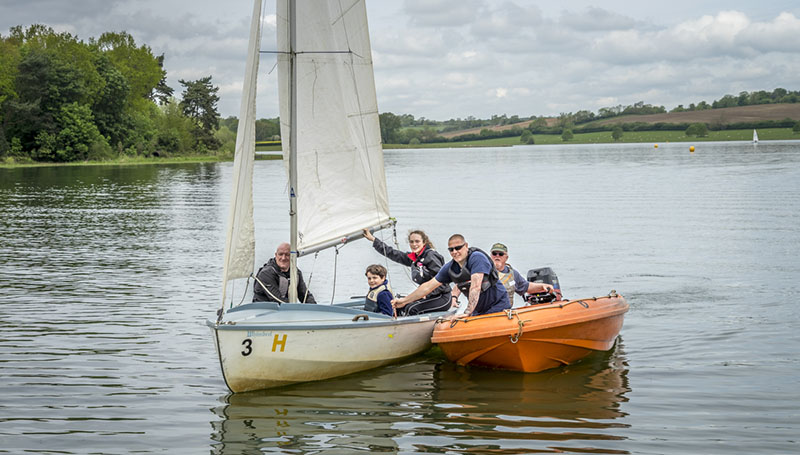Boat Officers & ABO Guide

The safe operation of the Club is designated to the Duty Officer and Boat Officer who have authority to:-
- Order all boats off the water e.g. if too many boats are capsizing or imminent thunder storm.
- Insist on addition safety cover before sailing is allowed.
- Cancel or postpone racing.
- Recommend children/novices do not sail.
- Order individuals off the water.
Responsibilities
The Boat Officer and Assistant Boat Officer...............
- WILL ATTEND EVERY capsize. Your priorities are entrapments/vulnerable people FIRST.
- REMEMBER - Engines OFF when approaching people in the water! Boat recovery is SECONDARY.
- Will have a second rescue boat equally fully equipped and ready to go i.e. with fuel and radio.
- Check that the boat is equipped according to the onboard checklist. Ensure you have enough fuel for the day.
- Make arrangements for cover when you are ‘off the water’ and boats are still out sailing.
Be vigilant....and give priority rescues to....
- Any boat with the potential for an entrapment.
- Any boat where they cannot see a person in the water or on top of their boat
- Children or frail adults where periods in the water can lead to hypothermia
Similarly the following may be de-prioritised:
- Anyone sitting on top of their boat (and safe)
- Anyone who has made it to shore (and safe)
Rescue and Boat Kit
Each safety boat should have the following equipment on board:
- Anchor
- First Aid Kit
- Tool Kit
- Safety knife
- Two paddles
- Tow rope with carabiner
- Throw bag
- Mooring lines
- Kill cord (in place)
- Spare kill cord (in canister)
- Fire Extinguisher
- Fuel Tank (with sufficient fuel)
- Laminated HSC Map and kit list
ENTRAPMENTS
- Watch the RYA YouTube video (first 10 mins).
- SAILORS NOTE - Consider masthead buoyancy
- Swift Response (positioning of boat)
- Count Heads (if no heads seen straight away)
- Right the boat (get on the centre board ...probably both of you)
- Free the sailor
- Recover the sailors
If you are not sure about any of the above or there has been a time gap between your duties, remember we do offer PB and SB refreshers. These are usually at the start of the sailing season, check with club calendar.

COLD WATER SHOCK
Cold Water Shock is a danger in water below 15°C; that’s more or less the summertime average around the coast of the UK. Please follow this link for good advice about Cold Water Shock
Duty Cover
Rescue Boat cover is to be provided during the programmed sailing times:-
- Saturdays 13:30 until 18:00
- Sundays & BH Mondays 10:30 until 18:00
- Sundays (Nov & Dec) 10:30 until 16.30
- Tuesday and Thursday 18:00 approx. until dusk
REMEMBER: You are covering the times identified, not just when racing ends.
Personnel Check
- Driver must have a minimum RYA Powerboat level 2 qualification and if aged between 16 and 18, the crew must be aged 18 or older. If the driver is over 18, the minimum age for the crew is 16.
- The crew must be physically able to assist with a rescue, and one member of the team must be dressed to enter the water. Make sure you are appropriately dressed for long periods on the water. Sun cream in summer…thermals, gloves, dry-suit in winter.
- Not having a RYA Safety boat certificate does not stop you from being a duty boat officer - it is highly recommended you do this course!

The Weather
Discuss the forecast with the Duty Officer and look at the weather to determine how many safety boats may be required. Use the following guidelines:
- Wind greater than Force 3 (7-10 Knots) and 15 or more craft out then 2 safety boats should be considered.
- Wind greater than Force 4 (11-16 Knots) and 15 or more craft out then 2 safety boats should be in place.
- If more boats on the water or conditions dictate get more boats ready.



Getting Ready
To do list
- Report to the Duty Officer and put your name on the white board
- Speak to your ABO an discuss their experience and what you expect them to do.
- Ensure you have a briefing with the Duty Officer - before going out.
- Complete a radio check
Filling the fuel tanks
- Take the fuel tank outside to fill.
- Use gloves and googles provided.
- The stainless steel cans have the nozzle on the reverse side of the cap.
- Remember to unscrew bleeder valve (screw) to allow air in as petrol flows out
- Fuel tank must be secured to the boat whilst in use.
- Ensure you have enough petrol. For example, all day on the water in windy conditions, and you will find you will probably need to re-fill!
Killcords
- All our boats need a kill cord attached to operate.
- RIBS/STAN need a killcord plus a key
- A spare kill cord must remain attached to every fuel can for use in emergency. These are kept in a yellow canister attached to petrol can.
- Kill cords will be worn (properly) at all times - no exceptions!

Honda Engines
- With our new engines comes new petrol cans - the 'air value' is permanently open (see image). LEAVE THEM ALONE!
- RIB keys - attach the bungee cord around the control throttle (as image) and this will keep the key in place.







